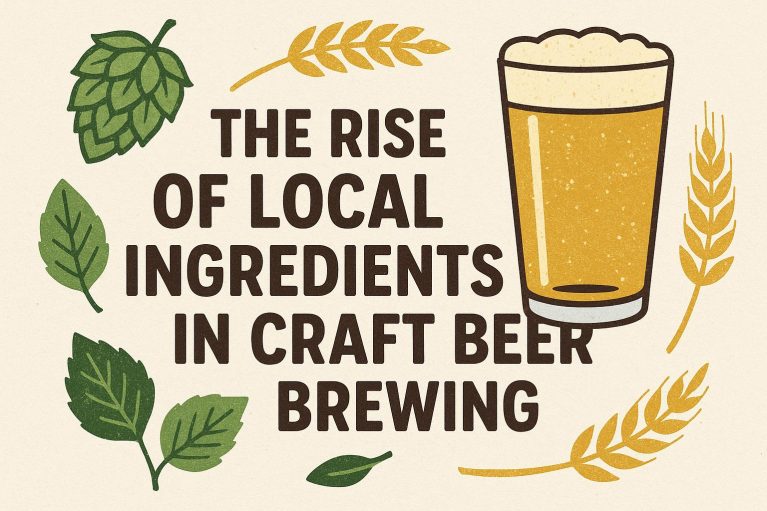The Growing Trend of Local Ingredients in Craft Beer Brewing
Over the past decade, the craft beer industry has experienced a significant transformation, with breweries increasingly focusing on using local ingredients. This shift reflects broader trends in sustainability, community support, and unique flavor development.
Why Breweries Choose Local Ingredients
The drive toward local sourcing is primarily influenced by the desire to create beer that embodies a sense of place. By using local ingredients, brewers can craft unique flavors that reflect their geographical region. This provides an opportunity to craft a distinctive taste profile that sets their products apart from others using more generic or globally-sourced components.
Furthermore, sustainability plays a crucial role. Locally sourced ingredients often have a lower carbon footprint due to reduced transportation needs. When breweries choose to support local farmers and producers, they are also fostering closer communal ties and contributing to the strengthening of regional economies.
Local Ingredients Transforming Flavor Profiles
One of the major changes brought about by local sourcing in craft brewing is the diversification of flavor profiles. By utilizing locally grown hops, breweries can explore unique flavor combinations that might not be possible with conventional varieties. Additionally, local grains and even native fruits or herbs can lead to the development of innovative beer styles, brimming with characteristics and nuances that express the particular terroir of the region.
For instance, the use of locally sourced grains such as barley or wheat introduces brewers to subtleties in texture and taste that distinguish their beers. Local hop varieties, too, tend to carry flavors that are unique to the soil, climate, and cultivation methods particular to a region. Rarely found elsewhere, these ingredients can turn into the definitive highlights of a recipe. Additionally, local fruits and herbs bring originality and a fresh spin to traditional brewing. These contributions of local ingredients can result in beers that are not only seasonal but também an authentic representation of a brewery’s immediate environment.
Challenges in Using Local Ingredients
While beneficial, using local ingredients is not without challenges. One key issue is the availability and quality consistency of local products. Unlike commercially available ingredients, local sources might have seasonal variations that can affect both brewing schedules and output. Brewers need to develop strong relationships with local suppliers, focusing on collaboration and communication to align expectations. At times, adjustments to recipes might be necessary based on seasonal availability of ingredients. This adaptability can lead to innovation but also requires skilled craftsmanship to maintain the desired beer quality.
Moreover, local sourcing might involve higher costs, impacting the pricing of the final product. It’s no secret that the craft brewing industry operates on narrow margins; the additional cost of locally sourced ingredients poses another challenge. Brewers have to delicately balance these factors to maintain the sustainability of their business while upholding the quality and distinctiveness of their beers. Strategically, some breweries might pass on the increased costs to consumers, who are often willing to pay more for a product that supports local agriculture and offers a unique taste experience.
The Future of Craft Brewing and Local Ingredients
The trend of using local ingredients is expected to grow as consumer interest in sustainability and authenticity increases. This movement aligns seamlessly with the broader food and beverage industry trend that emphasizes traceability and the farm-to-table concept. Craft breweries, recognized for their innovation and community involvement, are undeniably well-positioned to lead the charge in this endeavor.
Looking ahead, brewers may explore deeper collaborations with local farmers, perhaps engaging in joint ventures that focus on developing new varieties of ingredients tailored specifically for brewing. Such partnerships could provide stability in ingredient supply and cost, while introducing new dimensions to the flavors that consumers experience in craft beers. For those interested in exploring this trend further, numerous resources and case studies are available from organizations and local brewery associations. These provide insights into successful partnerships between breweries and local producers. They offer valuable lessons for both new and established brewers looking to incorporate local ingredients into their processes.
Moreover, the emphasis on local ingredients could spur innovations beyond flavors, reaching into packaging and brewing processes. Sustainable practices like using recycled materials and eco-friendly brewing methods might become more prevalent as part of a broader commitment to environmental responsibility. This holistic sustainability approach could attract consumers who are increasingly aware of not just what they consume but how it is produced and its impact on the environment.
The future journey promises exciting developments as brewers continue to navigate the complexities and opportunities provided by local sourcing. As breweries fine-tune their practices to cultivate strong local ties, the synergy between craft beer and local agriculture might birth an era rich in creativity and resilience, laying a robust foundation for the craft beer industry for generations to come.

